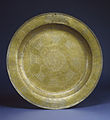Mahmud the Kurd
Mahmud the Kurd (also Mahmud al-Kurdi,[1] Master Mahmud,[2] Kurdish: Mehmûdê Kurdî) was a 15th-century Kurdish artist, craftsman and designer of the late medieval era.[3][4]
Life and work
[edit]Mahmud is regarded as one of the founders of an artistic style which is termed Veneto-Saracenic (Venetian-Islamic) by art historians.[5][6]
Mahmud's work include several stylistic sub-groups, which have in common the frequent use of European shapes combined with a new style of linear silver inlay displaying an unconventional style of arabesque.[7] Their decoration displays affinities with that on metalwork made during the same period for the Timurid dynasty in Central Asia and eastern Iran and the Mamluk rulers of Egypt and Syria. According to Tahera H. Tajbhai "his skillful designs makes his style immediately recognizable, signaling him out as one of the leading Veneto-Saracenic craftsmen. His style adopted new innovative style whilst still retaining elements of Mamluk tradition."[8]
The location of Mahmud's workshop is disputed. It is believed that he immigrated to Venice where he lived and set up a workshop in the second half of the 15th century and introduced oriental metalwork into Venice.[9][10][11][12][13] However, some scholars have questioned the thesis that Muslim artists have worked in Venice, they suggest that they produced their objects in their home countries and exported them to Europe.[14][15] Therefore, there are two more alternative theories proposed based on Mahmdu's style of work, some scholars suggest that his work is originated from Aq Qoyunlu lands in eastern Anatolia or western Iran,[16][17] while others argue that there is no visual evidence for a connection between the Veneto-Saracenic and Iranian or Aq Qoyunlu homologues, and they place his work in Mamluk Sultanate in Egypt or Syria.[18]
Only 13 objects, 12 of which carry his full name and one without his nisba (the Kurd), have survived.[19] They are preserved in the British Museum, The Victoria and Albert Museum in London, and the Hermitage Museum in St. Petersburg.[20] He usually signed his name on his pieces in Arabic and Latin script as "mu'allim mahmud al kurdi", which means master Mahmud the Kurd.[21]
Gallery
[edit]-
Mahmud the Kurd- Tray (Salver)
-
Mahmud the Kurd - Tray (Salver)
References
[edit]- ^ Mack, Rosamond E.; Mack Smith, Denis (2002). Bazaar to Piazza: Islamic Trade and Italian Art, 1300-1600. University of California Press. p. 142. ISBN 978-0-520-22131-4.
- ^ Auld, Sylvia. ""Master Mahmud and Inlaid. Metalwork in the 15th Century,"". Venice and the Islamic World. Ed. Carboni. 2.18-19. 39.
- ^ Auld, Sylvia (2004). Renaissance Venice, Islam and Mahmud the Kurd: A Metalworking Enigma. Altajir World Of Islam Trust. ISBN 978-1-901435-11-5.
- ^ HALI: The International Journal of Oriental Carpets and Textiles. Oguz Press. 2006. p. 26.
- ^ Auld, Sylvia (2004). Renaissance Venice, Islam and Mahmud the Kurd: A Metalworking Enigma. Altajir World Of Islam Trust. pp. 9, 63, 81. ISBN 978-1-901435-11-5.
- ^ Necipoğlu, Gülru; Behrens-Abouseif, Doris; Contadinia, Anna (2004). Essays in Honor of J.M. Rogers. BRILL. p. 52. ISBN 978-90-04-13964-0.
- ^ Behrens-Abouseif, Doris (2005). "'Veneto-Saracenic Metalware, a Mamluk Art.'". Mamluk Studies Review. 9 (2): 147–172.
- ^ Tajbhai, Tahera (2016-05-19). "A Fearsome Beauty: Material and Cultural Exchange between Venice and the Islamic Near East". School of Arts & Sciences Theses: 28.
- ^ Ettinghausen, Richard (1984). Islamic Art and Archaeology: Collected Papers. Gebr. Mann Verlag. p. 1157. ISBN 978-3-7861-1412-3.
Muslim brassworkers like Mu`allim Mahmud al - Kurdi, Zayn al - Din, and others who shortly after 1500 manufactured and signed ' all ' Azimina " vessels in Venice where, however, their style soon underwent a Europeanization.
- ^ Ahmad, Ziauddin; Suleri, Ziauddin Ahmad (1994). Influence of Islam on World Civilization. Royal Book Company. p. 255. ISBN 978-969-407-164-0.
Some of the immortal names of those masters of art who came to Venice are Mahmud - al - Kurdi, Zainuddin ' Omar, Qasim, Habibullah - Ibn - Ali Baharjani and Alauddin Birjandi
- ^ Sinclair, Susan (2012-04-03). Bibliography of Art and Architecture in the Islamic World (2 vol. set). BRILL. p. 408. ISBN 978-90-474-1207-6.
- ^ London, Society of Antiquaries of (1906). Proceedings of the Society of Antiquaries of London. The Society. p. 378.
- ^ Galleries, Courtauld Institute (1967). The Gambier-Parry Collection: Provisional Catalogue 1967. Courtauld Institute of Art, University of London. p. 24.
Mahmud al - Kurdi, the best known of the Iranian craftsmen recorded as active in Venice
- ^ Alaoui, Brahim (2007-01-01). Venice and the Islamic World, 828-1797. Yale University Press. p. 218. ISBN 978-0-300-12430-9.
- ^ Darke, Diana (2020-08-20). Stealing from the Saracens: How Islamic Architecture Shaped Europe. Oxford University Press. p. 233. ISBN 978-1-78738-305-0.
- ^ Staff, Abrams, Harry N.; Irwin, Robert (1997). Islamic Art in Context: Art, Architecture, and the Literary World. Harry N. Abrams. p. 227. ISBN 978-0-8109-2710-0.
{{cite book}}: CS1 maint: multiple names: authors list (link) - ^ Hook, Duncan R.; Gaimster, David R. M. (1995). Trade and Discovery: The Scientific Study of Artefacts from Post-Medieval Europe and Beyond. Department of Scientific Research, British Museum. ISBN 978-0-86159-109-1.
- ^ Behrens-Abouseif, Doris (2009-01-01). "The Jalayirid Connection in Mamluk Metalware". Muqarnas Online. 26 (1): 149–159. doi:10.1163/22118993-90000147. ISSN 0732-2992.
- ^ Carboni, Stefano (2007-01-01). Venice and the Islamic World, 828-1797. Yale University Press. pp. 218, 328–30. ISBN 978-0-300-12430-9.
- ^ Bloom, Professor of Islamic Art Jonathan M.; Bloom, Jonathan; Blair, Sheila S.; Blair, Sheila (2009-05-14). Grove Encyclopedia of Islamic Art & Architecture: Three-Volume Set. OUP USA. p. 392. ISBN 978-0-19-530991-1.
- ^ Galleries, Courtauld Institute (1967). The Gambier-Parry Collection: Provisional Catalogue 1967. Courtauld Institute of Art, University of London. p. 24.


